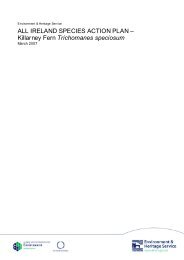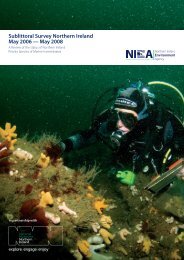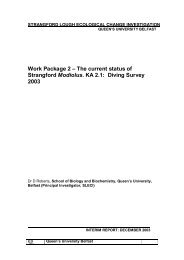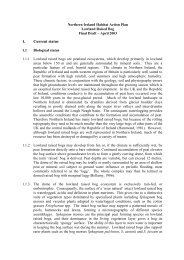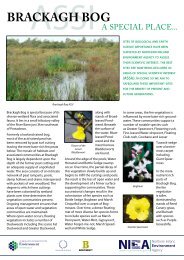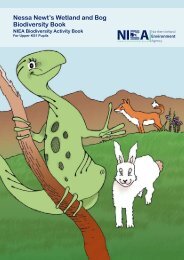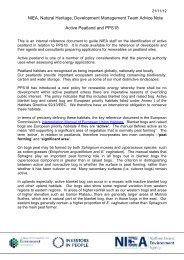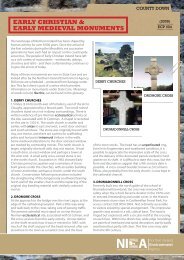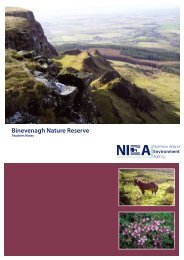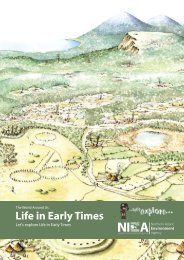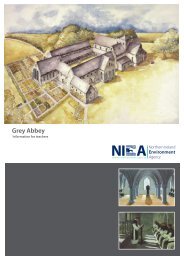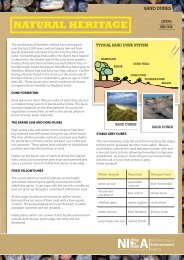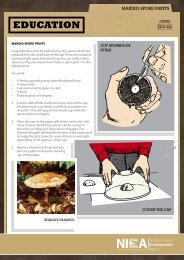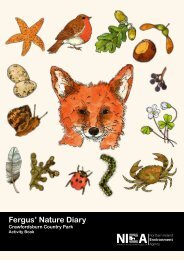Heavily Modified and Artificial Water Bodies - Neagh Bann River ...
Heavily Modified and Artificial Water Bodies - Neagh Bann River ...
Heavily Modified and Artificial Water Bodies - Neagh Bann River ...
You also want an ePaper? Increase the reach of your titles
YUMPU automatically turns print PDFs into web optimized ePapers that Google loves.
<strong>Neagh</strong> <strong>Bann</strong> <strong>River</strong> Basin Management Plan<br />
<strong>Heavily</strong> <strong>Modified</strong> <strong>and</strong> <strong>Artificial</strong> <strong>Water</strong><br />
<strong>Bodies</strong> - <strong>Neagh</strong> <strong>Bann</strong> <strong>River</strong> Basin District<br />
December 2009<br />
90
In this appendix:<br />
GBNI3NB0021 <strong>and</strong> GBNI1NB060602017 – CAM LOUGH AND<br />
BESSBROOKRIVER<br />
GBNI1NB030307049 - CLAY LAKE, CALLAN RIVER<br />
GBNI1NB030307048 - SEAGHAN RESERVOIR<br />
GBNI1NB030307109 -KILLEN WATER, ARMAGH<br />
GBNI1NB030307025 - RIVER RHONE, DUNGANNON<br />
GBNI1NB030307173 -ALTMORE, TORRENT RIVER<br />
GBNI1NB030304060 -RIVER BALLINDERRY<br />
GBNI3NB0027 <strong>and</strong> GBNI1NB030303005 -LOUGH FEA AND WHITE WATER<br />
GBNI1NB030303144 -COPPIES BURN MAGHERAFELT<br />
GBNI1NB030305162 -PLASKETTS BURN<br />
GBNI1NB030305122 -SIX MILE WATER, ANTRIM<br />
GBNI1NB030305204 -SIX MILE WATER, BALLYCLARE<br />
GBNI1NB030302199 -KILLYLANE RESERVOIR<br />
GBNI1NB030302233 -DUNGONNELL DAM<br />
GBNI1NB030302018 -RIVER BRAID, BALLYMENA<br />
GBNI1NB030301149 - LOWER BANN, PORTGLENONE<br />
GBNI1NB030301220 - LOWER BANN, BALLYMONEY<br />
GBNI1NB030301214 - LOWER BANN, SOUTH COLERAINE<br />
GBNI1NB030301071 - BALLINREES<br />
GBNI3NB0017 <strong>and</strong> GBNI1NB030308188 - LOUGH ISLAND REAVY AND<br />
MUDDOCK RIVER<br />
GBNI3NB0026 <strong>and</strong> GBNI1NB030308089 - SPELGA DAM AND RIVER BANN<br />
GBNI1NB030308197 -UPPER BANN AT BANBRIDGE<br />
GBNI1NB030308103 - UPPER BANN AT BANNFOOT<br />
91
GBNI3NB0013 - LOUGH BEG<br />
GBNI3NB00032 – LOUGH NEAGH<br />
GBNI1NB030306208 - LOUGH NEAGH PERIPHERALS<br />
GBNI1NB030306194 - AGHALEE RIVER<br />
GBNI1NB030307145 - COALISLAND CANAL AND<br />
TORRENT RIVER<br />
GBNI1NB060604048 - NEWRY CANAL<br />
(new wb id GBNI1NB060601023)<br />
APPENDIX IV<br />
GBNI3NB0024 <strong>and</strong> GBNI1NB030306083 - STONEYFORD RESERVOIR AND<br />
STONEYFORD RIVER<br />
GBNI1NB030302022 -QUOLIE<br />
92
GBNI3NB0021 <strong>and</strong> GBNI1NB060602017 - WE / DWS<br />
Impoundment Name/Works Cam Lough<br />
Morphological Impact Yes<br />
Impoundment Present<br />
Height of Impoundment 3m<br />
Compensation Flow Ml/D Yes 3.19<br />
Hydrology Impacted Yes<br />
Wider Environment ASSI (wetl<strong>and</strong> mesotrophic lake) AONB<br />
93<br />
© Crown copyright<br />
<strong>and</strong> database rights<br />
OSNI EMOU206.2
Cam Lough <strong>and</strong> Bessbrook <strong>River</strong><br />
Camlough is designated as an ASSI because it is an example of a mesotophic lake <strong>and</strong><br />
these are becoming rare in Nothern Irel<strong>and</strong> due to pollution. It is currently described<br />
as being in unfavourable condition status meaning there is poor supportive habitat.<br />
The lake was raised in the 19 th Century by constructing an embankment along the<br />
northern shore of the lake <strong>and</strong> at the outlet. At the workshop it was discussed that<br />
there are no salmon or trout populations present.<br />
The morphology of the river has been re-aligned but this is not due to the flow. There<br />
are no sediment management plans or freshets in place but there is some<br />
compensation flow. This will need to be taken forward <strong>and</strong> discussed with NIW<br />
under AILRegs.<br />
GBNI3NB0021 WE / DWS<br />
Workshop Classification of reservoir: MEP<br />
Chemical status: Moderate<br />
Biological status: Moderate<br />
2009 Classification of reservoir: Moderate Ecological Potential.<br />
GBNI1NB060602017 - WE / DWS<br />
Workshop Classification of river: MEP<br />
Phys/Chem status: Good<br />
SP: Good<br />
Biological status: Poor (invertebrates)<br />
2009 Classification of river: PEP<br />
94
GBNI1NB030307049 – DWS<br />
Impoundment Name/Works Clay Lake, Callan <strong>River</strong><br />
Morphological Impact Yes<br />
Impoundment Present<br />
Height of Impoundment 1.8m<br />
Compensation Flow Ml/D Yes 1.1<br />
Hydrology Impacted No<br />
95<br />
© Crown copyright<br />
<strong>and</strong> database rights<br />
OSNI EMOU206.2
Clay Lake, Callan <strong>River</strong><br />
At the workshop, it was commented that for the past 3 or 4 years there have been<br />
good numbers of salmon below the impoundment. However it is unlikely that they<br />
would migrate into the lake <strong>and</strong> therefore it was felt that there was no barrier to<br />
migration. The morphological impact on the downstream channel still needs assessed<br />
using RHAT. However, modifications to sediment plans including use of freshets are<br />
under review <strong>and</strong> needs further discussion with NIW. There is a small abstraction<br />
from the lake but it is not impacting on hydrology as there is some compensation<br />
flow.<br />
GBNI1NB030307049 – DWS<br />
Workshop classification: MEP<br />
Phys/Chem status: Nothing<br />
SP: Nothing<br />
Biological status: Poor (invertebrates)<br />
2009 Classification: PEP<br />
96
GBNI1NB030307048 – DWS<br />
Impoundment Name/Works Seaghan Reservoir<br />
Morphological Impact Yes<br />
Impoundment Present<br />
Height of Impoundment 20m<br />
Compensation Flow Ml/D Yes 1.14<br />
Hydrology Impacted Yes<br />
97<br />
© Crown copyright<br />
<strong>and</strong> database rights<br />
OSNI EMOU206.2
Seaghan Reservoir<br />
At the workshop, Loughs Agency says there is no known impact on fish migration.<br />
The hydrology of the downstream river is impacted. Although there is some<br />
compensation flow, it was not felt that the volume is adequate <strong>and</strong> this is a measure<br />
that could be implemented. The morphology of the downstream river is most likely<br />
impacted in terms of the sediment regime. Sediment management plans could be put<br />
in place <strong>and</strong> the freshets reviewed, as they are not adequate. <strong>Water</strong> chemistry of the<br />
downstream river needs assessed in terms of Dissolved Oxygen as the compensation<br />
flow from the reservoir may impact on the channel.<br />
GBNI1NB030307048 – DWS<br />
Workshop classification: MEP<br />
Phys/Chem status: Moderate<br />
SP: Good<br />
Biological status: Moderate (invertebrates)<br />
2009 Classification: MEP<br />
98
GBNI1NB030307109 – FRM<br />
99<br />
© Crown copyright<br />
<strong>and</strong> database rights<br />
OSNI EMOU206.2
Killeen <strong>Water</strong> (Armagh)<br />
The Killeen <strong>Water</strong> flows through mixed agriculture <strong>and</strong> dairy l<strong>and</strong> to Armagh town.<br />
It is confined in parts through a natural valley. There was localized flooding of the<br />
urban area recently when a drain became blocked.<br />
From the workshop it is known there are some alterations to the channel including a<br />
sluice <strong>and</strong> small weirs. The channel is likely to have been re-aligned <strong>and</strong> the<br />
waterbody has around 24% of the channel culverted with no potential to re-open due<br />
to the urbanisation. The channel re-alignment has caused a loss in diversity that may<br />
be rectified by increasing in-channel habitats <strong>and</strong> retaining what is present.<br />
There are some questions remaining regarding vegetation control <strong>and</strong> to the<br />
alterations of flow <strong>and</strong> sediment by artificial means. Further information is required.<br />
GBNI1NB030307109 – FRM<br />
Workshop Classification: MEP<br />
Phys/Chem status: Nothing<br />
SP: Nothing<br />
Biological status: Bad (invertebrates)<br />
2009 Classification: BEP<br />
100
GBNI1NB030307025 – FRM<br />
101<br />
© Crown copyright<br />
<strong>and</strong> database rights<br />
OSNI EMOU206.2
<strong>River</strong> Rhone (Dungannon)<br />
This water body is extensively urbanized through the town <strong>and</strong> the bus station wall<br />
runs along the river side. There are approximately 1.5km of culverts <strong>and</strong> the old mill<br />
race is still going through Moygashel Mill. There are inlets from surface drainage <strong>and</strong><br />
an outfall from the sewage works at Moygashel. No invasive alien plants have been<br />
noted in-channel or on the banks. Other l<strong>and</strong> uses include agriculture <strong>and</strong> a golf<br />
course.<br />
From the workshop it was discussed that the presence of weirs <strong>and</strong> impoundments<br />
were impacting on the migration of eels. The impoundment most likely remains for<br />
aesthetic reasons. However, apart from sticklebacks the water quality is too poor to<br />
support other species. It is not known whether the mill race is still abstracting or if<br />
the channel is now acting like a canal habitat. Depending on its functionality the mill<br />
race could be blocked <strong>and</strong> the water re-diverted.<br />
GBNI1NB030307025 – FRM<br />
Workshop Classification: MEP<br />
Phys/Chem status: Nothing<br />
SP: Nothing<br />
Biological status: Bad (invertebrates)<br />
2009 Classification: BEP<br />
102
GBNI1NB030307173 – DWS<br />
Impoundment Name/Works Altmore, Torrent <strong>River</strong><br />
Morphological Impact Yes<br />
2 Impoundments Present<br />
Height of Impoundment 7m <strong>and</strong> 16m<br />
Compensation Flow Ml/D No<br />
Hydrology Impacted Yes<br />
103<br />
© Crown copyright<br />
<strong>and</strong> database rights<br />
OSNI EMOU206.2
Altmore, Torrent <strong>River</strong><br />
At the workshop it was recognized there are fish including trout downstream but the<br />
habitat in the reservoir is not favourable for salmon or trout. There may be issues<br />
regarding eels. The impoundments are having a hydrological <strong>and</strong> morphological<br />
impact on the river downstream. There is no compensation flow at present but the<br />
measure is practicable in theory; however this requires further discussion with NIW as<br />
do measures regarding sediment, which are dependent on compensation flow. It was<br />
suggested that a pipe from the lower reservoir that flows to the works could provide<br />
additional flow <strong>and</strong> may be practicable.<br />
GBNI1NB030307173 – DWS<br />
Workshop Classification: MEP<br />
Phys/Chem status: Moderate<br />
SP: Moderate<br />
Biological status: Poor (fish <strong>and</strong> invertebrates)<br />
2009 Classification: PEP<br />
104
GBNI1NB030304060 – FRM / WE<br />
105<br />
© Crown copyright<br />
<strong>and</strong> database rights<br />
OSNI EMOU206.2
Ballinderry <strong>River</strong><br />
This water body is dominated by pastures <strong>and</strong> urbanisation. It is most likely<br />
reinforced where the river meets the urban area to prevent flooding. From the map<br />
there appear to be 3 weirs, however their size <strong>and</strong> barrier to fish movement is not<br />
known. From the unverified pressure layers there appear to be 4 sluices <strong>and</strong> 5<br />
impoundments. Where the Fairy Bridge is shown on the map, this stretch of the river<br />
appears artificially straightened. Feeder streams are likely to be culverted but not to a<br />
large extent. The cement works at Knockaconny abstracts <strong>and</strong> discharges <strong>and</strong><br />
Cookstown sewage works discharges into the Ballinderry <strong>River</strong>. There may be a risk<br />
of migration of Giant Hogweed upstream of the waterbody. There is an ASSI at the<br />
bottom of water body.<br />
At the workshop it was felt that the pressures present were not significant or had<br />
measures in place which are adequate but this needs reviewed with regards to the<br />
actions required. The significance <strong>and</strong> control of giant hogweed was discussed.<br />
Abstractions are not having an impact on water body as they do not a significant daily<br />
volume.<br />
GBNI1NB030304060 – FRM / WE<br />
Workshop Classification: GEP<br />
Phys/Chem status: Good<br />
SP: High<br />
Biological status: Poor (macrophytes)<br />
2009 Classification: PEP<br />
106
GBNI3NB0027 <strong>and</strong> GBNI1NB030303005 -WE / DWS<br />
Impoundment Name/Works Lough Fea<br />
Morphological Impact Yes<br />
Impoundment Present<br />
Height of Impoundment 5m<br />
Compensation Flow Ml/D No<br />
Hydrology Impacted Yes<br />
Wider Environment AONB Sperrin<br />
107<br />
© Crown copyright<br />
<strong>and</strong> database rights<br />
OSNI EMOU206.2
Lough Fea <strong>and</strong> White <strong>Water</strong><br />
At the workshop it was discussed that the impoundment is having an impact on the<br />
migration of fish but that there are measures in place <strong>and</strong> these are adequate. Also,<br />
the marshy area downstream would prevent fish getting upstream, but the lough is<br />
stocked with fish. There is a hydrological impact on the downstream channel but<br />
because it is a low yield system it is unlikely that a baseline flow can be established as<br />
they would need to reduce the capacity of the works, but the channel could<br />
practicably be re-engineered. This would need discussed with NIW. Sediment is<br />
removed from the catchment (s<strong>and</strong> <strong>and</strong> gravel).<br />
GBNI3NB0027 -WE / DWS<br />
Workshop Classification of reservoir: GEP<br />
Chemical Status: Good<br />
Biological status: High<br />
2009 Classification of reservoir: GEP<br />
GBNI1NB030303005 -WE / DWS<br />
Workshop Classification of river: MEP<br />
Phys/Chem status: High<br />
SP: High<br />
Biological status: Moderate (macrophytes)<br />
2009 Classification of river: MEP<br />
108
GBNI1NB030303144 – FRM<br />
109<br />
© Crown copyright<br />
<strong>and</strong> database rights<br />
OSNI EMOU206.2
Coppies Burn (Magherafelt)<br />
The main l<strong>and</strong> covers are the urban areas of Magherafelt <strong>and</strong> pastures. The Coppies<br />
Burn flows into the Moyola. The Coppies Burn is culverted in large parts under the<br />
town with associated artificial straightening <strong>and</strong> most likely impacts on the migration<br />
of fish. Within the Polepatrick Cemetery Park there are gabion baskets. There is a<br />
small amount of embankment in the waterbody by Lowertown. Other pressures may<br />
include outfalls at Acheson <strong>and</strong> Glover <strong>and</strong> the small Magherafelt sewage works.<br />
At the workshop it was discussed that the channel had been lowered by a metre due to<br />
a mill race <strong>and</strong> this has caused a significant adverse ecological impact. However, best<br />
practice measures are in place to retain habitat but issues regarding water quality need<br />
resolved before development of in-channel features are approached. The inlets <strong>and</strong><br />
outfalls to the channel also impact on hydromorphological alterations <strong>and</strong> drainage<br />
plans to align <strong>and</strong> attenuate the flow should be put in place. Note there is planned<br />
work to retro-fit some of the existing culverts.<br />
Acheson <strong>and</strong> Glover have put in a stepping channel for fish under advice from DCAL.<br />
This has opened up half of the catchment <strong>and</strong> work is being carried out to restock the<br />
river. DCAL advised us that the stepping channel should be suitable for the migration<br />
of all fish species.<br />
GBNI1NB030303144 – FRM<br />
Workshop Classification: MEP<br />
Phys/Chem status: Good<br />
SP: High<br />
Biological status: Poor (invertebrates)<br />
2009 Classification: PEP<br />
110
GBNI1NB030305162 – FRM<br />
111<br />
© Crown copyright<br />
<strong>and</strong> database rights<br />
OSNI EMOU206.2
Plasketts Burn (Antrim)<br />
The Plasketts Burn water body incorporates part of Antrim town <strong>and</strong> arable l<strong>and</strong>.<br />
There is also a golf course <strong>and</strong> army base along this stretch. The river is very straight<br />
<strong>and</strong> has extensive culverts through the town. There is a weir noted with field <strong>and</strong> road<br />
drains present.<br />
More information is required on the distribution of bank side alien species. The<br />
<strong>Water</strong> Quality Inspector (WQI) for the area revealed that there are weirs present <strong>and</strong><br />
these do not pose a significant problem. L<strong>and</strong> management strategies are in place but<br />
it is felt that these were not adequate <strong>and</strong> future development plans should include<br />
best practice. This would require further liaison with the Planning Service.<br />
GBNI1NB030305162 – FRM<br />
Workshop Classification: MEP<br />
Phys/Chem status: Nothing<br />
SP: Nothing<br />
Biological status: Poor (invertebrates)<br />
2009 Classification: PEP<br />
112
GBNI1NB030305122 – FRM<br />
113<br />
© Crown copyright<br />
<strong>and</strong> database rights<br />
OSNI EMOU206.2
Six Mile <strong>Water</strong> (Antrim)<br />
The Six Mile <strong>Water</strong> downstream of Doagh has bed <strong>and</strong> bank reinforcement <strong>and</strong> some<br />
culverts. There are weirs on the stretch with fish passes present on two weirs at<br />
Dunadry. The channel has been artificially straightened. The class ‘A’ river<br />
macrophyte, <strong>Water</strong> Crowfoot, is present in stream. There is urban, arable, grassl<strong>and</strong><br />
<strong>and</strong> forestry l<strong>and</strong> use in this area.<br />
From the workshop it was clear that there are numerous in-channel features including<br />
around 17 weirs. However, opinion at the workshop was that these are not affecting<br />
the migration of fish. Following a site visit by the rivers hydromorphology team<br />
further investigation into the weir at the technology park may be required. It is<br />
unclear whether this weir is acting as a barrier to migration of sediment <strong>and</strong> biota.<br />
The river has been re-aligned through the urban areas, particularly through Antrim<br />
<strong>and</strong> the lower reaches for navigation purposes. Dredging took place a couple of years<br />
ago from where the marina is located up to the army base. Works are also being<br />
carried out at the bottom of the water body in terms of reinforcement.<br />
Small enhancement programmes may be underway already. There is scope to increase<br />
the diversity of in-channel features.<br />
Note from further investigation Dunadry mill race historically has a pressure from<br />
Hydrocotyle which is an in-channel alien plant species.<br />
GBNI1NB030305122 – FRM<br />
Workshop Classification: MEP<br />
Phys/Chem status: Good<br />
SP: High<br />
Biological status: Poor (fish <strong>and</strong> diatoms)<br />
2009 Classification: PEP<br />
114
GBNI1NB030305204 - FRM<br />
115<br />
© Crown copyright<br />
<strong>and</strong> database rights<br />
OSNI EMOU206.2
Six Mile <strong>Water</strong> (Ballyclare)<br />
The Six Mile <strong>Water</strong> through Ballyclare has reinforced banks <strong>and</strong> smaller streams<br />
which are culverted. L<strong>and</strong> uses in the catchment are urban <strong>and</strong> agriculture with<br />
outfalls from field <strong>and</strong> road drains <strong>and</strong> the Ballyclare sewage works.<br />
At the workshop there were no significant impacts from any of the pressures<br />
identified. Note that the sewage works have been recently upgraded.<br />
GBNI1NB030305204 - FRM<br />
Workshop Classification: GEP<br />
Phys/Chem status: Good<br />
SP: High<br />
Biological status: Moderate (invertebrates)<br />
2009 Classification: MEP<br />
116
GBNI1NB030302199 – DWS<br />
Impoundment Name/Works Killylane Reservoir<br />
Morphological Impact Yes<br />
Impoundment Present<br />
Height of Impoundment Unknown m<br />
Compensation Flow Ml/D No<br />
Hydrology Impacted Yes<br />
117<br />
© Crown copyright<br />
<strong>and</strong> database rights<br />
OSNI EMOU206.2
Killylane Reservoir <strong>and</strong> Glenwhirry <strong>River</strong><br />
At the workshop it was discussed that the most significant impact was on the<br />
downstream river’s hydrology <strong>and</strong> morphology. It was discussed whether it would be<br />
possible to redirect flow downstream of the Crosswater abstraction intakes but this<br />
may reduce Killylane’s capacity. Alternatively abstracting water during winter on the<br />
Crosswater may be stopped to allow freshets or spills to take place. This would need<br />
discussed with NIW as would sediment management plans. The Killylane report 10<br />
suggested that the flow did not have a huge impact on the biology downstream. It<br />
was felt that the impoundment was not acting as a physical barrier to native migratory<br />
fish as the upstream reaches would not provide suitable habitat for spawning.<br />
GBNI1NB030302199 – DWS<br />
Workshop Classification: MEP<br />
Phys/Chem status: High<br />
SP: High<br />
Biological status: Good (Moderate fish*)<br />
2009 Classification: MEP<br />
*Following UKTAG guidance the fish were not able to downgrade classification.<br />
10 Assessment of the effect of impoundment on the status of the Killylane Burn <strong>and</strong> Glenwhirry <strong>River</strong>,<br />
<strong>and</strong> their derogation as “<strong>Heavily</strong> <strong>Modified</strong> <strong>Water</strong> <strong>Bodies</strong>”. Bláithín Ní Ainín, Ian Donohue, Martyn<br />
Kelly <strong>and</strong> Kenneth Irvine. Freshwater Ecology Research Group <strong>and</strong> Bowburn-consultancy.co.uk<br />
118
GBNI1NB030302233 – DWS<br />
Impoundment Name/Works Dungonnell Dam<br />
Morphological Impact Yes<br />
Impoundment Present<br />
Height of Impoundment 13m<br />
Compensation Flow Ml/D Yes 0.45<br />
Hydrology Impacted Yes<br />
Wider Environment ASSI, AONB, RAMSAR, SAC, SPA<br />
119<br />
© Crown copyright<br />
<strong>and</strong> database rights<br />
OSNI EMOU206.2
Dungonnell Dam <strong>and</strong> Ballysallagh <strong>Water</strong><br />
At the workshop it was clear that the hydrology in the downstream river is impacting<br />
on the blanket bog <strong>and</strong> lakes due to the fluctuation in flows. NIW have stated that<br />
0.45 ML/day is released from the reservoir which approximately equates to the Q95<br />
flow of the river. However, this figure needs validated. A suggestion was to reduce<br />
the intake from Inver Burn. The baseline flow may not be adequate <strong>and</strong> should be<br />
taken forward with NIW. In addition, both sediment management plans <strong>and</strong> freshets<br />
should be discussed with NIW as these are not in place <strong>and</strong> would improve the<br />
downstream river.<br />
GBNI1NB030302233 – DWS<br />
Workshop Classification: MEP<br />
Phys/Chem status: High<br />
SP: High<br />
Biological status: Good<br />
2009 Classification: MEP<br />
120
GBNI1NB030302018 – FRM<br />
121<br />
© Crown copyright<br />
<strong>and</strong> database rights<br />
OSNI EMOU206.2
Braid (Ballymena)<br />
The Braid travels through the largely urban parts of Ballymena where the tributaries<br />
are extensively culverted. The number of weirs present is unknown but field <strong>and</strong> road<br />
drains are present. Flood defences are present at Tullygarley New Bridge <strong>and</strong> the<br />
Gallaghers factory. There is agricultural l<strong>and</strong> in the north of this water body.<br />
From the workshop it was clear that there are numerous pressures on this waterbody<br />
including a lot of physical alterations to the channel. Of these the main mitigation that<br />
could be put in place are l<strong>and</strong> management strategies for the rural areas. <strong>Water</strong> quality<br />
on the Braid <strong>River</strong> remains an issue. Of the two known weirs it is unclear whether the<br />
weir at Devenagh has a fish pass. However, there are fish present above the weirs so<br />
it is unlikely that their migration is hindered.<br />
GBNI1NB030302018 – FRM<br />
Workshop Classification: MEP<br />
Phys/Chem status: High<br />
SP: High<br />
Biological status: Poor (macrophytes)<br />
2009 Classification: PEP<br />
122
GBNI1NB030301149 – FRM / NAV<br />
123<br />
© Crown copyright<br />
<strong>and</strong> database rights<br />
OSNI EMOU206.2
Lower <strong>Bann</strong> at Portglenone<br />
The main l<strong>and</strong> cover along the river is forestry <strong>and</strong> pasture. Other pressures include<br />
elver slips, eel traps <strong>and</strong> sewage works discharges. The water body is likely impacted<br />
by flow regulation from Lough <strong>Neagh</strong>. However, the areas closest to the channel are<br />
prone to flooding suggesting no flood banks are in place. Reinforcement is found<br />
along the urbanised areas of Kilrea <strong>and</strong> Portglenone. In addition some reinforcement<br />
will be found at the flood gates, canals (including Portna) <strong>and</strong> marinas. From<br />
resources available there appears to be 2 sluices, 2 impoundments <strong>and</strong> 3 weirs,<br />
although these are unverified. It is believed these weirs have fish passes. There are 2<br />
fish farms, one at Movanagher. It is not known how much water is abstracted <strong>and</strong> the<br />
significance if any, there is on the rest of the channel. Navigation pressures are likely<br />
to have impacted on this water body.<br />
At the workshop it was decided to incorporate both flood risk management <strong>and</strong><br />
navigation for this water body. The Lower <strong>Bann</strong> has been widened <strong>and</strong> deepened due<br />
to the gates at Toome <strong>and</strong> the canals in this water body get dredged for navigation but<br />
this is done under a licence agreement with NIEA. Fish farms abstract a significant<br />
amount of water but there is probably no hydrological impact. The areas closest to<br />
the channel still flood <strong>and</strong> are subject to poaching. However, it is unpractical to<br />
implement fencing in these areas due to the river’s connectivity with the floodplain.<br />
The banks are also subject to boat wash which increases erosion. Commercial peat is<br />
extracted from the top of Lough Beg.<br />
GBNI1NB030301149 – FRM / NAV<br />
Workshop Classification: MEP<br />
Phys/Chem status: Moderate<br />
SP: High<br />
Biological status: Poor (macrophytes)<br />
2009 Classification: PEP<br />
124
GBNI1NB030301220 – FRM<br />
125<br />
© Crown copyright<br />
<strong>and</strong> database rights<br />
OSNI EMOU206.2
Lower <strong>Bann</strong> (Ballymoney <strong>River</strong>)<br />
The main l<strong>and</strong> cover is urbanisation <strong>and</strong> pasture at Ballymoney. There is<br />
reinforcement through the town <strong>and</strong> the river is embanked only in a small section.<br />
From the resources available there is a sluice, 2 impoundments <strong>and</strong> 3 weirs, including<br />
one at Balnamar Bridge that has recently been re-concreted although these are<br />
unverified. It is not known if any part of the river has been artificially straightened<br />
<strong>and</strong> only small feeder streams in the town are culverted. There are road <strong>and</strong> field<br />
drains as usual.<br />
At the workshop there was discussion that there is fish movement up the system as<br />
salmon are found up Breagh Burn. There is a healthy population of trout <strong>and</strong> it may<br />
be a sea trout spawning area. However, lamprey may be impeded by the weirs<br />
including the recently re-concreted Balnamar weir as it is not known whether there is<br />
a fish pass <strong>and</strong> is if it is suitable. Strategies could be put in place for both rural <strong>and</strong><br />
urban pressures, if not present already. Habitat could be improved in some areas<br />
particularly through the park area; however, its ecological benefits may not be<br />
significant.<br />
GBNI1NB030301220 – FRM<br />
Workshop Classification: MEP<br />
Phys/Chem status: Moderate<br />
SP: Good<br />
Biological status: Poor (invertebrates)<br />
2009 Classification: PEP<br />
126
GBNI1NB030301214 – FRM / NAV<br />
127<br />
© Crown copyright<br />
<strong>and</strong> database rights<br />
OSNI EMOU206.2
Lower <strong>Bann</strong> South of Coleraine<br />
This water body is subject to the flow control at Lough <strong>Neagh</strong>. The main l<strong>and</strong> cover<br />
is pasture <strong>and</strong> forestry. On a local scale there seems to be no artificial straightening.<br />
Where the road meets the river there may be some old reinforcement but on a minor<br />
scale. Minor reinforcement may be observed at the jetties, slipways <strong>and</strong> marina. The<br />
pumping station may abstract but more information is required. Navigation pressures<br />
are likely to have impacted on this waterbody.<br />
At the workshop it was decided to incorporate both flood risk management <strong>and</strong><br />
navigation for this water body. The channel is probably re-graded due to the flood<br />
gates at Toome. Navigation pressures are eroding the bank which may be causing<br />
significant ecological impacts. The l<strong>and</strong> cover is also impacting on the channel as<br />
there is little buffer between fields <strong>and</strong> the river. Countryside management schemes<br />
may not be adequate as it is unpractical to implement fencing in these areas due to the<br />
rivers connectivity with the floodplain, buffer zones of trees may prove more<br />
beneficial. The distribution of Himalayan Balsam is unknown. Following a site visit,<br />
rhododendron was densely distributed in small pockets.<br />
<strong>River</strong>s Agency has started an erosion project on a section of this water body to<br />
counteract the impact of boat wash on the river banks. The use of “log Christmas<br />
trees,” will help the energy from the waves of the boats be absorbed rather than<br />
eroding the banks.<br />
GBNI1NB030301214 – FRM / NAV<br />
Workshop Classification: MEP<br />
Phys/Chem status: Good<br />
SP: High<br />
Biological status: Poor (diatoms)<br />
2009 Classification: PEP<br />
128
GBNI1NB030301071 – DWS<br />
Impoundment Name/Works Ballinrees<br />
Morphological Impact Impoundment Present<br />
Height of Impoundment 9m<br />
Compensation Flow Ml/D No<br />
Hydrology Impacted No<br />
129<br />
© Crown copyright<br />
<strong>and</strong> database rights<br />
OSNI EMOU206.2
Ballinrees<br />
At the workshop it was discussed that there is a morphological impact on the<br />
downstream river. Measures regarding sediment are dependent on compensation flow<br />
<strong>and</strong> therefore discussions with NIW are required. There is potential to split this water<br />
body to assist with Programmes of Measures. The river is known to be stocked by a<br />
local angling club.<br />
GBNI1NB030301071 – DWS<br />
Workshop Classification: MEP<br />
Phys/Chem status: Good<br />
SP: High<br />
Biological status: Poor (invertebrates)<br />
2009 Classification: PEP<br />
130
GBNI3NB0017 <strong>and</strong> GBNI1NB030308188 - DWS<br />
Impoundment Name/Works Lough Isl<strong>and</strong> Reavy<br />
Morphological Impact Yes<br />
Impoundment Present<br />
Height of Impoundment 11m<br />
Compensation Flow Ml/D Yes 10.90<br />
Hydrology Impacted Yes<br />
131<br />
© Crown copyright<br />
<strong>and</strong> database rights<br />
OSNI EMOU206.2
Lough Isl<strong>and</strong> Reavy <strong>and</strong> Muddock <strong>River</strong><br />
At the workshop it was discussed that the reservoir was built for the Banbridge flax<br />
industry. Historical maps indicated that it was a natural lake that has been<br />
impounded.<br />
In the summer more water is taken from the reservoir than goes in, but NIW say they<br />
don’t abstract much as this is only a supplementary source. There were suggestions to<br />
focus on Muddock <strong>River</strong> rather than Lough Isl<strong>and</strong> Reavy. The left channel has been<br />
diverted <strong>and</strong> has subsequently left the channel relatively dry. There may be an<br />
inadequate compensation flow for Muddock <strong>River</strong> which requires a fixed water level.<br />
Morphologically the river has been altered downstream. Sediment management plans<br />
may be a measure that could be implemented but this needs discussed with NIW.<br />
More information is required on the migration of fish in this water body as it was<br />
questioned at the workshop.<br />
GBNI3NB0017 – DWS<br />
Workshop Classification of reservoir: MEP<br />
Chemical status: Moderate<br />
Biological status: Moderate<br />
2009 Classification: MEP<br />
GBNI1NB030308188 – DWS<br />
Workshop Classification of river: MEP<br />
Phys/Chem status: Moderate<br />
SP: High<br />
Biological status: Poor (macrophytes)<br />
2009 Classification: PEP<br />
132
GBNI3NB0026 <strong>and</strong> GBNI1NB030308089 - DWS<br />
Impoundment Name/Works Spelga Dam<br />
Morphological Impact Yes<br />
Impoundment Present<br />
Height of Impoundment 30m<br />
Compensation Flow Ml/D Yes 2.28<br />
Hydrology Impacted Yes<br />
133<br />
© Crown copyright<br />
<strong>and</strong> database rights<br />
OSNI EMOU206.2
Spelga Dam <strong>and</strong> <strong>River</strong> <strong>Bann</strong><br />
At the workshop the main impacts are on the hydrology <strong>and</strong> morphology of the river<br />
downstream. Flow is impacted but the compensation flow is adequate (greater than<br />
the Q95 low flow) <strong>and</strong> therefore this is screened out. Downstream of the<br />
impoundment is engineered but not for a significant distance. Mitigation measures to<br />
implement sediment management plans <strong>and</strong> freshets are a possibility but would need<br />
taken forward with NIW. Sheep dipping is also present in the area.<br />
GBNI3NB0026 - DWS<br />
Workshop Classification of reservoir: MEP<br />
Chemical status: Good<br />
Biological status: Bad<br />
2009 Classification: MEP or worse<br />
There was insufficient biological data available to provide a more specific<br />
classification. Diatom data was unavailable at the time of classification <strong>and</strong> UKTAG<br />
guidance recommended not using macrophytes or fish for classification as they would<br />
be reflecting the hydromorphological pressure that is associated with its use.<br />
GBNI1NB030308089 – DWS<br />
Workshop Classification of river: MEP<br />
Phys/Chem status: High<br />
SP: High<br />
Biological status: Good<br />
2009 Classification: MEP<br />
134
GBNI1NB030308197 – FRM<br />
135<br />
© Crown copyright<br />
<strong>and</strong> database rights<br />
OSNI EMOU206.2
Upper <strong>Bann</strong> at Banbridge<br />
The Upper <strong>Bann</strong> flows through Banbridge where there are some flood defences such<br />
as boulders <strong>and</strong> soil embankments on the main river with some stone weirs. There are<br />
extensive culverts on the small streams <strong>and</strong> approximately 50 discharge pipes. There<br />
is also a discharge from the sewage treatment works at Huntley Bridge. The rural<br />
areas are mostly used for grazing by cattle <strong>and</strong> sheep <strong>and</strong> there are a few industrial<br />
discharges.<br />
From the workshop the main mitigation identified concerned future development<br />
plans <strong>and</strong> l<strong>and</strong> use strategies that were probably not adequate <strong>and</strong> could be put in<br />
place. The HEP scheme at Lawrencetown was questioned as to if there were any<br />
potential impacts. Salmon <strong>and</strong> trout are found upstream but it is unclear if other fish<br />
species are impacted on. Alien plant species such as Giant Hogweed are removed<br />
when there is a health <strong>and</strong> safety issue but not in relation to bank destabilisation.<br />
<strong>Water</strong> quality may be an issue because of the number of outlets but it was felt these<br />
would be dealt with under drainage plans.<br />
GBNI1NB030308197 – FRM<br />
Workshop Classification: MEP<br />
Phys/Chem status: Good<br />
SP: High<br />
Biological status: Moderate (invertebrates <strong>and</strong> macrophytes)<br />
2009 Classification: MEP<br />
136
GBNI1NB030308103 – FRM / NAV<br />
137<br />
© Crown copyright<br />
<strong>and</strong> database rights<br />
OSNI EMOU206.2
Upper <strong>Bann</strong> at <strong>Bann</strong>foot<br />
The Upper <strong>Bann</strong> between Portadown <strong>and</strong> <strong>Bann</strong>foot has been designated as heavily<br />
modified due to inl<strong>and</strong> navigation. The channel is reinforced at Portadown with a slip<br />
way <strong>and</strong> fishing st<strong>and</strong>s. There are canoe steps above Shillington’s Bridge <strong>and</strong> an old<br />
weir above Knock Bridge for the Canal. More information on dredging in the channel<br />
is required.<br />
At the workshop it was decided both flood risk management <strong>and</strong> navigation is<br />
applicable for this water body. The river banks at Portadown have been reinforced<br />
but this was not thought to be significant. The river upstream of Portadown has been<br />
over-deepened for navigation purposes. Margins are being retained. 26% of the banks<br />
are flood-protected mainly to protect the agricultural l<strong>and</strong> usage. All are vegetated<br />
earth banks with no trees. This does impact on the connectivity of the channel with<br />
the floodplain although the river does flood into the floodplain closer to Lough<br />
<strong>Neagh</strong>.<br />
GBNI1NB030308103 – FRM / NAV<br />
Workshop Classification: MEP<br />
Phys/Chem status: Moderate<br />
SP: High<br />
Biological status: Poor (invertebrates)<br />
2009 Classification: PEP<br />
138
GBNI3NB0013 – FRM/WE/NAV<br />
© Crown copyright<br />
<strong>and</strong> database rights<br />
OSNI EMOU206.2<br />
139
Lough Beg<br />
Lough Beg is an ASSI, RAMSAR site <strong>and</strong> SPA. It was formed by a widening of the<br />
Lower <strong>Bann</strong> <strong>and</strong> is relatively shallow (max 2m deep) with the exception of the<br />
dredged navigation channel (up to 4m deep). The Northern Irel<strong>and</strong> Lake Survey 11<br />
estimated the turnover time varies from 0.3 days in January to 5 days in July. The<br />
hydrological regime is controlled by the Toome sluice gates 3km upstream of the<br />
lake. The water levels have been artificially lowered <strong>and</strong> are also dependent on the<br />
levels within the rest of the Lower <strong>Bann</strong> system. The natural variability of water<br />
levels will no longer occur.<br />
From the workshop it was discussed that all measures are in place <strong>and</strong> adequate for<br />
this water body.<br />
GBNI3NB0013<br />
Hydromorphological Classification: GEP<br />
Chemical status: Poor<br />
Biological status: Poor (phytoplankton, diatoms <strong>and</strong> macrophytes)<br />
2009 Classification: PEP<br />
11 Lawrie E W., Wolfe-Murphy S.A., <strong>and</strong> Gibson. C.E., 1992. Northern Irel<strong>and</strong> Lakes Survey Vol 7.<br />
Large lakes; a botanical survey of the Eight largest lakes in Northern Irel<strong>and</strong>.<br />
140
GBNI3NB00032-FRM/WE<br />
141<br />
© Crown copyright<br />
<strong>and</strong> database rights<br />
OSNI EMOU206.2
Lough <strong>Neagh</strong><br />
Lough <strong>Neagh</strong> is designated as a RAMSAR site, ASSI <strong>and</strong> SPA. Lough <strong>Neagh</strong> has<br />
been lowered as part of various drainage schemes to prevent flooding of agricultural<br />
l<strong>and</strong>. The net effect of this is an overall lowering of between 2-3m. The water levels<br />
are now controlled by the sluice gates at Toome <strong>and</strong> therefore the natural regime of<br />
high <strong>and</strong> low water levels no longer occurs.<br />
From the workshop it was discussed that all hydromorphological measures are in<br />
place <strong>and</strong> adequate for this water body.<br />
GBNI3NB00032<br />
Hydromorphology Classification: GEP<br />
Chemical Status: Bad<br />
Biological status: Bad (macrophytes)<br />
2009 Classification: BEP<br />
142
ADDITIONAL WATER BODY<br />
GBNI1NB030306208 - FRM<br />
143<br />
© Crown copyright<br />
<strong>and</strong> database rights<br />
OSNI EMOU206.2
Lagan Canal, Goudy <strong>River</strong>, Lough <strong>Neagh</strong> Peripherals<br />
A desk top study was carried out with NIEA Freshwater Monitoring <strong>and</strong> Assessment<br />
Team, The WMU hydrology team <strong>and</strong> the WMU hydromorphology team. It was<br />
assessed that in-channel, marginal <strong>and</strong> riparian habitats could be improved. The<br />
Lagan peripherals are managed to prevent flooding, so it is not known how feasible it<br />
will be to incorporate restoration measures without causing increased flood risk.<br />
Individual assessments may be required on a site by site basis.<br />
Hydromorphological Classification: MEP<br />
Phys/Chem status: Moderate<br />
SP: High<br />
Biological status: Bad (invertebrates)<br />
2009 Classification: BEP<br />
144
ADDITIONAL WATER BODY<br />
GBNI1NB030306194 – FRM<br />
145<br />
© Crown copyright<br />
<strong>and</strong> database rights<br />
OSNI EMOU206.2
Aghalee <strong>River</strong><br />
A desk top study was carried out with NIEA Freshwater Monitoring <strong>and</strong> Assessment<br />
Team, The WMU hydrology team <strong>and</strong> the WMU hydromorphology team. It was<br />
assessed that there is no impact from hydromorphological alterations of water <strong>and</strong><br />
sediment input from artificial means. Although <strong>River</strong>s Agency <strong>and</strong> Natural Heritage<br />
confirmed there is vegetation control carried out along the river they agree this<br />
management is not having an adverse ecological impact. The marginal <strong>and</strong> riparian<br />
habitats could be improved along with an increase in-channel morphological<br />
diversity.<br />
GBNI1NB030306194 – FRM<br />
Hydromorphological Classification: MEP<br />
Phys/Chem status: Nothing<br />
SP: Nothing<br />
Biological status: Poor (invertebrates)<br />
2009 Classification: PEP<br />
146
ADDITIONAL WATER BODY<br />
GBNI1NB030307145 - FRM<br />
147<br />
© Crown copyright<br />
<strong>and</strong> database rights<br />
OSNI EMOU206.2
Coalisl<strong>and</strong> Canal, Torrent <strong>River</strong><br />
The Coalisl<strong>and</strong> Canal <strong>and</strong> the Torrent <strong>River</strong> are intertwined with the <strong>River</strong> flowing<br />
directly though the canal in several places leaving the river course to become<br />
sluggish. The river has been narrowed <strong>and</strong> extensively reinforced. Site visits were<br />
undertaken in March 2009 confirming the presence of weirs, a canal lock gate,<br />
embankments <strong>and</strong> the alien bank side species Giant Hogweed. No current navigation<br />
activities were obvious.<br />
L<strong>and</strong> uses include agriculture, industry <strong>and</strong> urban areas, rubbish was evident in the<br />
channel, <strong>and</strong> there were indications of pollution.<br />
GBNI1NB030307145 - FRM<br />
Hydromorphological Classification: MEP<br />
Phys/Chem status: Moderate<br />
SP: Good<br />
Biological status: Poor (macrophytes <strong>and</strong> diatoms)<br />
2009 Classification: PEP<br />
148
ARTIFICIAL WATER BODY (AWB)<br />
GBNI1NB060604048 – NAV (New WB ID June 09) GBNI1NB060601023<br />
149<br />
© Crown copyright<br />
<strong>and</strong> database rights<br />
OSNI EMOU206.2
Newry Canal<br />
The Newry Canal water body was designated as artificial within new water body<br />
boundaries defined in 2009. A desk top study was carried out by the NIEA<br />
Freshwater Monitoring <strong>and</strong> Assessment Hydrology teams. The UKTAG mitigation<br />
measures spreadsheet was completed <strong>and</strong> a moderate ecological potential concluded<br />
due to the presence of hard bank protection which has reduced the marginal <strong>and</strong><br />
riparian habitat, <strong>and</strong> locks <strong>and</strong> weirs along the canal without proper fish passage.<br />
GBNI1NB060604048<br />
Hydromorphological Classification: MEP<br />
Phys/Chem status: Nothing<br />
SP: Nothing<br />
Biological status: Nothing<br />
2009 Classification: MEP<br />
150



